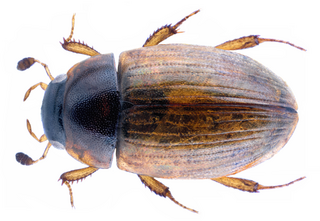
Cercyon is a genus of water scavenger beetles in the family Hydrophilidae. There are at least 50 described species in Cercyon.
Cercyon impressus is a species of water scavenger beetle in the family Hydrophilidae. It is found in Europe & Northern Asia and North America.
Cercyon cinctus is a species of water scavenger beetle in the family Hydrophilidae. It is found in North America.
Cercyon limbatus is a species of water scavenger beetle in the family Hydrophilidae. It is found in North America.
Cercyon roseni is a species of water scavenger beetle in the family Hydrophilidae. It is found in North America.

Cercyon quisquilius is a species of water scavenger beetle in the family Hydrophilidae. It is found in Africa, Australia, Europe & Northern Asia, Central America, North America, Oceania, South America, and Southern Asia.
Cercyon luniger is a species of water scavenger beetle in the family Hydrophilidae. It is found in Central America and North America.
Cercyon mendax is a species of water scavenger beetle in the family Hydrophilidae. It is found in North America.

Cercyon haemorrhoidalis is a species of water scavenger beetle in the family Hydrophilidae. It is found in Australia, Europe & Northern Asia, North America, and Southern Asia.
Cercyon assecla is a species of water scavenger beetle in the family Hydrophilidae. It is found in North America.
Cercyon laminatus is a species of water scavenger beetle in the family Hydrophilidae. It is found in Europe & Northern Asia, Oceania, and Southern Asia.
Cercyon littoralis is a species of water scavenger beetle in the family Hydrophilidae. It is found in Europe & Northern Asia and North America.

Cercyon ustulatus is a species of water scavenger beetle in the family Hydrophilidae. It is found in Europe & Northern Asia and North America.
Cercyon adumbratus is a species of water scavenger beetle in the family Hydrophilidae. It is found in North America.
Cercyon analis is a species of water scavenger beetle in the family Hydrophilidae. It is found in Australia, Europe & Northern Asia, and North America.
Cercyon floridanus is a species of water scavenger beetle in the family Hydrophilidae. It is found in North America.
Cercyon fimbriatus is a species of water scavenger beetle in the family Hydrophilidae. It is found in Central America and North America.
Cercyon connivens is a species of water scavenger beetle in the family Hydrophilidae. It is found in North America.
Cercyon herceus is a species of water scavenger beetle in the family Hydrophilidae. It is found in North America.
Cercyon pygmaeus is a species of water scavenger beetle in the family Hydrophilidae. It is found in Europe & Northern Asia and North America.






